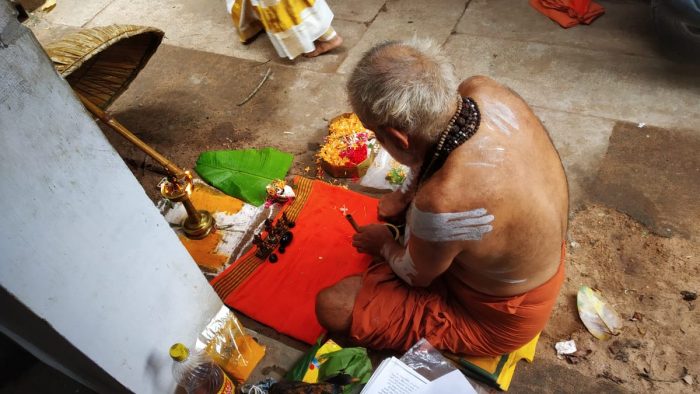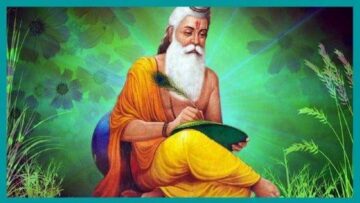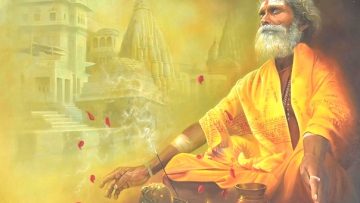The world has seen the rise and fall of many empires and many cultures in the course of its history of about three thousand years. Some perished without leaving any traces of their existence. For example, most of the traditions that existed in Europe and the Middle East before the advent of Christianity and Islam have gone into oblivion. Likewise the Mayan and Inca civilizations of South America have disappeared. But the Vedic culture of India has been preserved till date, in spite of foreign invasions and frequent disruptions to the social and cultural life.
The reasons can be analysed. Philosophy, Mythology and Ritual are the essential parts of every religion. If they are loosely connected to each other then it becomes difficult for a religion to survive. On the other hand if there is a strong bondage between the three, then the religion and the culture survive. Ancient Indians understood this principle and developed a close linkage between the three and thus preserved a great tradition.
There is a fair amount of philosophy in the mythological texts like the Purāṇas which also speak about the ritual traditions. So our Vedānta ācāryas quote profusely from the purāṇas in support of their philosophical arguments. While the Vedic texts were called as śruti, the purāṇas were treated like the smṛtis and both were held as authorities and were respected.
Likewise the performance of rituals was considered to be mandatory for people of all walks of life. Even a sannyāsin is expected to perform some of the rituals. It is, therefore, no wonder that the ritual traditions have a strong base in the philosophy of the land. The Gṛhyasūtras speak mainly on the saṁskāras or the rituals to be performed by people of all walks of life.
The word saṁskāra itself has a strong philosophical background. Śabara in his Jaiminīya-bhāṣya (3.1.3.660) defines it thus: ‘that which being effected makes an object or a person fit for a certain purpose’. Tantra-vārtika (3.8.9.1115) says ‘it is an action or a rite which imports fitness, arising from the removal of sins or from the generation of fresh qualities’. Vīramitrodaya (I.37) says, ‘saṁskāra is a peculiar excellence due to the performance of ordained rites which resides either in the soul or in the body and is of two kinds, one kind qualifying a person for the performance of other rites and the other removing the congenital defects (e.g. jātakarma).
Some of the saṁskāras pertain to the physiological events in a man’s life (birth rites) while some others cater to the social recognition of a particular status (e.g. Marriage rites). There are others which act on the psychology of man (rites which are meant to protect from evil influences).
The philosophical value of the saṁskāras also cannot be ruled out. Any person aiming to attain the ‘Highest Reality’ (Brahmasākṣatkāra) has to equip himself with the sādhana-catuṣṭaya – (i) nityānitya-vastu-viveka (discrimination between the permanent and the ephemeral) (ii) vairāgya(renunciation in all respects) (iii) qualities like śama (tranquillity of mind’ dama (control of the sense organs) and śraddhā (faith), and (iv) Mumukṣutva— intense desire for liberation.
An aspirant to the highest philosophical truth has to hear (śravaṇa) the texts importing ‘highest knowledge’, analyse in the mind (manana) what he has learnt and meditate (nididhyāsana) upon the ‘Supreme self’. All these can be achieved only when the mind is pure. Mental purity (cittaśuddhi) can be achieved through religious practices or rites performed with śraddhā (faith).
Ritual is a graded discipline and it takes man step by step from overt religious activities for gaining material ends to the meditation on the ‘Highest Reality’. Rituals have to be performed in order to go beyond the rituals, in pursuit of higher goals.
Ritual is thus an indispensable first step while the sādhanacatuṣṭaya, etc. are further higher steps leading to the ‘Highest Goal’. It is an essential means to the end. Some of the statements of Śaṅkara on karma may be analysed here since they are quite significant from the point of view of the rituals.
यस्तु अधिकृतः सङ्गं त्यक्त्वा फलाभिसन्धिं च नित्यं कर्म करोति, तस्य फलरागादिना अकलुषीक्रियमाणं अन्तःकरणं नित्यैश्च कर्मभिः संस्क्रियमाणं विशुध्यति । तत् विशुद्धं प्रसन्नं आत्मालोचनक्षमं भवति । तस्य एव नित्यकर्मानुष्ठानेन विशुद्धान्तःकरणस्य आत्मज्ञानाभिमुखस्य क्रमेण यथा तन्निष्ठा स्यात् ।(Gītābhāṣya of Śrī Śaṅkarācārya, XVIII, 10, Ed. Sri Ramakrishna Math, Chennai, 2005)
When a man performs higher kinds of works (nitya-karma), his mind, or antaḥkaraṇa, unsoiled by desire for results –without attachment and longing for results – becomes regenerated and pure. When thus purified, the mind becomes fit for contemplation on the Self. Thus the man whose mind has been purified by the performance of obligatory works (nitya-karma) and who is thus prepared to acquire the self-realisation, may gradually attain the jñāna-niṣṭhā (the final end).
अनभिसंधाय फलमनुष्ठितानि यज्ञादीनि मुमुक्षोः ज्ञानसाधनानि भवन्ति इति प्रपञ्चितम् ।… धर्मविशेष अनुग्रहो विद्यायाः सम्भवति । ( Brahmasutra-bhāṣya of Śrī Śaṅkarācārya III.4.27-28)
The seekers of liberation must perform the rituals and other obligatory duties without any longing for the fruits of such works. When performed like that, the works prove useful as a means to the birth of Spiritual regeneration of the mind.
अनाश्रितः कर्मफलं कार्यं कर्म करोति यः। स सन्न्यासी च योगी च न निरग्निर्न चाक्रियः॥ (Bhagagadgītā, VI.1)
‘He who is free from the desire for the fruits of action and performs action as a bounded duty – not as a kāmya karma he who performs actions thus, is superior to those who perform action on a different spirit……one who is devoted to action abandoning attachment for the results of action— performs for purification of mind and is said to be a sannyāsin or a yogin.’
कर्मफलसङ्कल्पसन्न्यासात् सन्न्यासित्वं योगाङ्गत्वेन च कर्मानुष्ठानात् कर्मफलसङ्कल्पस्य च चित्तविक्षेपहेतोः परित्यागात् योगित्वं च इति गौणम् उभयम् । (Śaṅkara’s commentary on Bhagavadgītā, VI.1)
Rituals are thus meant for purification of the mind. Selfish desires and passions are impediments to self-realisation. Unselfish karma (duties when not done with self-seeking motives) removes impediments, effect a proper function of the mind, and then lead to the final realization.
The rituals make a man rise above the base instincts of rāga and dveṣa (affection and aversion to sense objects) and prepare the ground for the mind to reach higher levels.
Man is a member of a social community. He has to follow the rules and regulations prescribed for his community. He has to observe the moral and ethical codes prescribed. But religious ideas and rituals are rather personal. A person may or may not follow them. In such a case, why should the rituals be prescribed at all by śāstraic texts? Śaṅkara’s observation is worth noting here:
ज्ञानन्तु प्रमाणजन्यम्, यथाभूतविषयञ्च । न तत् नियोगशतेनापि कारयितुं शक्यते । न च प्रतिषेधशतेनापि वारयितुं शक्यते । वस्तुत्वं हि तत् अतोऽपि नियोगाभावः ।… न तु शास्त्रं भृत्यानिव बलात् निवर्तयति, नियोजयति वा । पुरुषाः स्वयमेव यथारुचि साधनविशेषं प्रवर्तन्ते । यस्य यथावभासः स यथारूपं पुरुषार्थं पश्यति तदनुरूपाणि साधनानि उपतिष्ठते । (Brahmasūtra-bhāṣya, 3.2.21 )
Man cannot be made an object of command (niyoga-viṣaya) from outside. Man is not a thing to be passively moulded and shaped from outside. He may be persuaded from outside. He may be persuaded by appealing to his inner mind but he cannot be controlled from outside.
ज्ञापकं हि शास्त्रम्, न तु कारकम् ।
Man chooses his end according to his own right and light. The śāstra only presents before him the lower and higher lines of conduct, but do not compel him to select a particular course of action. The śāstras do not mould the man to their own ideas of good; they can only appeal to his inner self.
उपासनेषु पूर्व्यस्मात् फलविशेषं उत्तरस्मिन् उपासने दर्शयति । (Brahmasūtra-bhāṣya, 4.3.16 and 3.4.5)
Again Śaṅkara points out that the ideas of good actions (rituals) and bad actions (vices) evolved within the community cannot be regarded as ends in themselves. For, he says, we find that the ideas of virtue and vice in a particular epoch of society differ from the ideas of virtue and vice in the next or another epoch.
Again in the same epoch of the community, different people select different works in a particular time and place are regarded otherwise in a different time and place. All these clearly show that virtues (and vices) are constantly evolving in higher and higher forms, they are constantly growing with the progressively growing communities of the worlds. They cannot therefore he regarded as the ultimate ends of life.
तेषां निरभिसन्धीनां नित्यानां कर्मणां आरात् उपकारकत्वात् मोक्षसाधनान्यपि कर्माणि भवन्ति इति न निरुध्यते । (BṛhadāraṇyakaUpaniṣad-Bhāṣya, 3-3-1 )
The saṁskāras, therefore, possess value in that they clear the mind of selfishness, sensuousness, and other base mentalities and prepare it for higher goals, through them. It is symbolic of life which has a continuous progress.
न च अनया कर्तव्यं परिसमाप्यते कस्यचित् । भगवत् तत्त्वे विदिते यत् सर्वं कर्तव्यं तत् सर्वं कृतं भवेत् ।
(Brahmasūtra-bhāṣya III.3.15)
The saṁskāras help one in cultivating the virtues, since his mind is mellowed down and is prepared to receive the instructions. The ethical and moral virtues to be cultivated are:
मैत्रीकरुणामुदितोपेक्षाणां सुखदुःखपुण्यापुण्यविषयाणां भावनातश्चित्तप्रसादनम् । (Patañjali’s Yogasūtra, I.33)
Śaṅkara also gives a list of virtues to imbibed, in his Bhagavadgītā-bhāṣya (XIII. 7-11 and XVI.1-3) such as absence of self-esteem, ahiṁsā (non-injury), constant equanimity, abandonment of deception etc.
Virtues cannot be inculcated overnight but they have to be imparted over a period of time. They have to be nourished and perfected. So long as they are not perfected, self-realization would remain incomplete. It is necessary therefore, to make life long endeavours towards the maturity of mind through the performance of Saṁskāras so as to attain a complete mastery over the base qualities and drive them away. This is the ethical aspect of the Saṁskāras. Moreover the Saṁskāras contribute to adṛṣṭaphala and are therefore of a higher value.
The performance of prescribed duties is helpful to the production of true knowledge by counteracting the wrong influences of such karmas as are antagonistic to the rise of true knowledge. The nitya and naimittika (absolutely and conditionally obligatory duties) should not be given up, for mere cessation from one’s duties has no meaning.
The real significance of the cessation from duties is that these should be performed without any motive of gain or advantage. It is wrong to suppose that emancipation can be attained only by those who renounce the world and become ascetics, for man of any caste (varṇa) and at any stage of life (āśrama) may attain it provided he follows his normal duties and is filled with spiritual thoughts.
Duties are threefold (i) nitya, absolutely obligatory. No special good or advantage comes out of their performance, but their non-performance is associated with evil effects. (ii) naimittika, those that are obligatory under certain conditions. If these are not performed under the special circumstances specified, sin will accrue, but no special benefits are produced by their performance. (iii) kāmya Optional duties that are performed only when a person is desirous of straining pleasurable ends. E.g. A sacrifice performed for the sake of obtaining a son. A man who wishes to attain emancipation should give up all kāmya duties but he should perform all nitya and naimittika duties.
Advaita never denies the empirical world. It only says that the empirical world is not as permanent as the Brahman, the Supreme Reality. It is also logical since there cannot be two Realities. Since the world does have vyāvahārika sattva, it has to be given due respect. We have to live in this world and transact all activities. Advaita only cautions us not to get attached to the world or the worldly activities.
But if we say ‘Don’t get attached’ the mind will not listen. On the other hand it will deliberately get attached. And so first we have to divert the mind from the worldly things and then train it to get detached. When the child is crying it will not eat. So the mother will divert its attention by showing some plaything. Once it stops crying it will eat.
Likewise the mind needs a diversion before turning to detachment. What is the best kind of diversion for the mind? It is bhakti or devotion to God. Advaita is not averse to God or bhakti towards God. By this bhakti, the jīva gets rid of his ahaṁkāra (ego) and attains sublimity.
In other words, the jīva should show utmost devotion (bhakti) towards God. Bhāgavata refers to nine aspects of bhakti– śravaṇa, kīrtana, pādasevana, smaraṇa, arcana, vandana, dāsya, sakhya, andātmanivedana. In addition to these, ārādhana (pleasing god) is also prescribed by the tradition. The rituals ordained in the Vedas and the Sūtras are to be performed steadfastly since they are intended to please God.
Whatever may be the aim of spiritual effort, the jīva must realize that he is doing it as an agent of the Supreme Brahman. It is a well-known fact that the jīva is in a state of bondage and has to get rid of it for attaining emancipation. The bondage, which has been continuing from time immemorial, cannot be dispensed with all of a sudden. Even death does not signify the end of all bondages. At the time of death the vital powers and the elements leave the individual only in part and follow him with other parts themselves.
मृतिकाले जहात्येनं प्राणा भूतानि पञ्च च । भागतो भागतस्त्वेनमनुगच्छन्ति सर्वशः॥ (Brahmasūtrabhāṣya, iii. 4).
Hence the jīva should perform all the prescribed religious duties and sādhanas in order to mitigate the sufferings caused by the results of the deeds accruing from the present and the previous births. Among the sādhanas, vairāgya cannot be attained unless the jīva realizes the utter dependence of everything in this world on God. Such a humility can be inculcated only if one performs the prescribed duties with utmost sincerity and devotion.
The Bhagavadgītā stresses on the importance of Karma at several places, e.g., कर्मणैव हि संसिद्धिमास्थिताजनकादयः॥ (Bhagavadgītā III. 20)
Even a liberated soul may perform the rituals not for his own sake, but for the sake of guiding the common people in the right path. The common man follows only that path which is adopted by a noble man. If he denounces the karma, the common man would also follow suit and lose thereby an opportunity to attain cittaśuddhi and subsequent benefits. Even Yogins therefore perform the rites prescribed but they do not attach themselves to the karma they do.
योगिनः कर्म कुर्वन्ति सङ्गं त्यक्त्वात्मशुद्धये । (VII. 11)
They perform karma without expecting any results since their minds are already free from desires. The common man should also try to emulate such persons.
योगस्थः कुरु कर्माणि सङ्गं त्यक्त्वा धनञ्जय । (II .43)
Performing karma does not mean that one may do the same according to one’s own will.
यः शास्त्रविधिमुत्सृज्य वर्तते कामकारतः। न स सिद्धिमवाप्नोति न सुखं न परमां गतिम् ॥
The karma is to be performed as prescribed in the scriptures. It is the ritual that is meant by the statement that karma is to be performed according to the śāstravidhi (Bhagavadgītā XVI. 23). The instruction is very clear in the line,
ज्ञात्वा शास्त्रविधिनोक्तं कर्म कर्तुमिहार्हसि । (XVI .24)
The fundamental aspect of life- the physical body, its importance and that of the food have been dwelt with at length in various Upaniṣads like the Taittirīya which says,
अन्नाद्वै प्रजाः प्रजायन्ते । याः काश्च पृथिवीं श्रिताः ।अथो अन्नेनैव जीवन्ति । अथैनदपि यन्त्यन्ततः॥ (ii.2.)
All the living beings are born from food, they are sustained by food and they end up in food. Food is the foremost one among all that is created. It is the medicine, par excellence. Those who worship food as Brahman, obtain food. Anna or food is symbolic of the physical body.
The inevitable first step in the realization of the Brahman is the true realization of the nature of the physical body. Unless the body is kept intact, other higher pursuits like spiritual practices cannot be undertaken, as rightly observed by Kālidāsa, शरीरमाद्यं खलु धर्मसाधनम् । (Kumārasaṁbhava V.33).
But the physical body is, after all, perishable by nature. Once the impermanent nature of the physical body is well grounded in the mind, it can be directed inwards to unearth higher truths of life. Hence the first step in the realization of higher philosophical truths is to consider food as the Brahman.
अन्नं न निन्द्यात् । तद् व्रतम् । प्राणो वा अन्नम् ।शरीरमन्नादम् । प्राणे शरीरं प्रतिष्ठितम् । शरीरे प्राणः प्रतिष्ठितः । तदेतदन्नमन्ने प्रतिष्ठितम् । स य एतदन्नमन्ने प्रतिष्ठितं वेद प्रतितिष्ठति । अन्नवानन्नादो भवति । प्रजया पशुभिः ब्रह्मवर्चसेन च महान् भवति । कीर्त्या च महान् भवति । (iii. 7)
One should not blame food. That should be observed as a pious rule. Life, indeed, is food. Body is the eater of the food. Body is set in life. Life is set in the body. Therefore food is established on food. So he who knows and contemplates on food, which is established in food, becomes firmly established. He becomes an enjoyer of food, commanding plenty of food. He becomes great in progeny, in cattle, and in effulgence of born of sacred wisdom. Owing to his righteous conduct, he becomes great.
In the same Upaniṣad it is said, ‘annaṁnaparicakṣīta’ food should not be rejected, and ‘annaṁbahukurvīta’– grow more food, etc. where the importance of food is stressed upon. It is in this context that we find offering food and partaking food is an important aspect of most of the rituals. In the śrāddha, for instance, it is pronounced, ‘annaṁca brahma, ahaṁca brahma.’
Thus food must be considered as Brahman. This realization leads to further contemplation and search into deeper realms of truth. The advancement must be made step by step, from the known to the unknown. From food, the gross aspect, we proceed to the subtler truths. Though food is essential for life, food is not all, since food is also subject to decay. So we proceed one step further; that is from materialism to vitalism.
The next step is to contemplate on the vital airs as Brahman. But prāṇa (vital air) also has an end. The next subtler aspect is the mind which being an organ has also its limitations. Next comes the individual soul that is the center of vijñāna or knowledge and enjoyment. Though the jīva has great powers, it cannot create or sustain the Universe. Greater than the jīva, therefore, is the Brahman, the Supreme Soul, which is the cause of the Universe and which is Bliss personified.
According to Rāmānuja, Bliss has to be sought through meditation, worship and adoration of the Supreme Soul, the Transcendent and the inner self of all entities. The best form of worship is self- surrender which generates an inclination towards divinity. God, the embodiment of love and compassion, showers His grace on the worshipper and puts an end to all his sufferings. Hence the jīva is to practice bhakti towards the Supreme Lord.
ब्रह्मप्राप्त्युपायश्च शास्त्राधिगततत्त्वज्ञानपूर्वकस्वकर्मानुगृहीतभक्ति निष्ठा साध्यानवधिकातिशयप्रियविशदतमप्रत्यक्षतापान्नानुध्यानरुपभक्तिरित्येवेत्युक्तम् । (Vedārthasaṁgraha, Edn. Ramakrishna Asrama, Mysore, 1978, para 238, p.184)
God is the possessor of all auspicious attributes. His glory is boundless. He is the principal entity (śeṣin).
तदेवं परस्य ब्रह्मणो ऽनवधिकातिशयासंख्येयकल्याणगुणगणाकरस्य निरवद्यस्यानन्तमहाविभूतेरनवधिकातिशयसौशील्यसौन्दर्यवात्सल्यजलधेः सर्वशेषित्वादात्मनः शेषत्वात्प्रतिबंधितयानुसंधीयमानम् अनवधिकातिशयप्रीतिविषयं सत्परं ब्रह्मैवैनम् आत्मानं प्रापयतीति । (Ibid. para. 243, p.186)
Madhva too advocates bhakti as a means to the realization of the Ultimate.
माहात्म्यज्ञानपूर्वस्तु सुदृढः सर्वतोऽधिकः। स्नेहो भक्तिरिति प्रोक्तस्तथा मुक्तिर्न चान्यथा ।। (Mahābhārata– tātparyanirṇaya, i.86).
Although Advaita differs from Viśiṣṭādvaita and Dvaita philosophically, some of the points on bhakti advocated by these two schools may be acceptable to Advaita with suitable changes.
The Bhagavadgītā says, he who serves me following the path of undivided bhakti transcends the qualities of prakṛti and will attain self-realization.
मां च योऽव्यभिचारेण भक्तियोगेन सेवते । स गुणान्समतीत्यैतां ब्रह्मभूयाय कल्पते ॥ (Bhagavadgītā XIV. 26.)
Such undivided bhakti is recommended through hymns that are employed in the gṛhya ceremonies. One or two examples may be given here. In the upasthāna mantra of the sandhyāvandana performed in the evenings, we have the mantra:
इमं मे वरुण श्रुधी हवमद्या च मृडय । त्वामवस्युरा चके ॥ (Taittirīyasaṁhitā, 2-1-1, Taittirīyamantrakoṣa, 1-4)
This mantra is pronounced during the upanayana also. It says,
‘O, Varuṇa, may you hear this prayer uttered by me. May you give bring us peace immediately. I praise you wholeheartedly, so you may protect me’. There is another mantra in praise of Agni, frequently employed in a number of ceremonies.
अयाश्चाग्नेऽस्यनभिशस्तीश्च सत्यमित्वमया असि । अयसा मनसा घृतोयसा हव्यमूहिषे अयानो धेहि भेषजम् ॥
(Taittirīyamantrakoṣa, 1-5)
‘O Agni, Indeed you are easily accessible to the devotees. You are free from all blemishes. Being adored through mind and deed, may you convey these offerings to the respective Gods. May you grant us good health and peace’ Being accessible to the devotees is a special quality of Gods. It speaks of the bondage between God and the devotee. Similarly possession of auspicious qualities and being free from defects are also extolled in the philosophical texts and in the devotional literature.
During the Upanayana, in between the mauñjīdhāraṇa, and the brahmopadeśa, the father performs a small ritual called parīdāna. He says, addressing his son, ‘अग्नये त्वा परिददामि, सोमाय त्वा परि ददामि, सवित्रे त्वा परि ददामि, यमाय त्वा परि ददामि, पृथिव्यै त्वा परि ददामि ॥ ’ (Āpastambapūrvaprayoga, Edn.Bhavani book center, Madras-33 p.142)
‘I am giving you to Agni, Soma, Savitar, Sarasvatī, Yama, Pṛthivī.’ The expressed sense does not fit in with the emotions prevailing at the time of the Upanayana of a young boy.
The proud father performing the most important ceremony involving his son will not be prepared to give away his son to anybody, even to the Gods, for that matter, and definitely not, to Yama, the God of Death.
The philosophical significance of the mantra alone is to be taken up here. The suggested sense is that the parents should not develop too much attachment towards their wards and spoil them. We have the proverb ‘Spare the rod and spoil the child.’ After the Upanayana, they have to send their son along with the teacher to a distant place for his education.
In fact, such a sense of detachment is recommended in every walk of life. The ‘vairāgya’ is one of the steps that lead to the Highest Goal. In fact, renunciation forms part of the sādhanacatuṣṭaya that are recommended for a spiritual aspirant. One should inculcate renunciation not only with respect to the material things but also for heaven and the like. Moreover giving away the son to a divinity may also imply that an individual is not quite different from the divinity – ‘jīvobrhmaivanāparaḥ’, which is the essence of Śaṅkara’s philosophy.
Thus we may see that the gṛhya ceremonies truly reflect the essential nature of Indian philosophy and affords scope for its different systems. Philosophy is therefore, part and parcel of the ritual system. This will not be quite surprising when we understand that the entire ritual system takes its origin from the Vedic tradition, which is the storehouse of the Philosophical systems as well.
The rituals are meant for all sections of the society, the smārtas, the vaiṣṇavas, the mādhvas and other sects. In fact they are meant for all the communities. The ritual mantras, present in the Upaniṣads, can be explained from the point of view of the different schools of Indian Philosophy. In Indian context philosophy and religion cannot be explained without reference to rituals. They are intertwined and inter-dependent. This is the beauty of ritual and philosophy with respect to Hinduism.
Bibliography
KokileswaraSastri, ‘An Introduction to Advaita Philosophy’, University of Calcutta, 1926.
(This paper was presented at the ‘Conference on Oneness’ jointly organized by Indic Academy and Chinmaya Vishwavidyapeeth, held in October 2019 in Kochi.)
Disclaimer: The opinions expressed in this article belong to the author. Indic Today is neither responsible nor liable for the accuracy, completeness, suitability, or validity of any information in the article.










